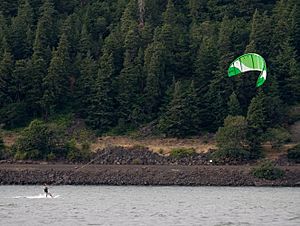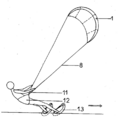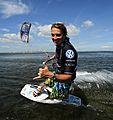Kite surfing facts for kids
Kite surfing (also called kiteboarding) is an exciting action sport that mixes parts of wakeboarding, snowboarding, windsurfing, surfing, paragliding, skateboarding, and sailing. It's an extreme sport where you use the power of the wind to glide across water, land, or snow.
Imagine holding onto a giant, controllable power kite that pulls you across the surface! It's a bit like flying while riding a board. Compared to other water sports that use wind, kiteboarding can be less expensive and easier to set up. It's also special because the kite catches wind from a much bigger area than a regular sail.
A kiteboarder uses a special board, sometimes with foot straps, and a large kite to move across the water. In 2006, it was estimated that about 150,000 to 210,000 people were kite surfing around the world! Many different ways to kite surf have become popular, like waveriding (riding ocean waves), freestyle (doing tricks), freeride (just cruising around), jumping (flying high!), and cruising (relaxed riding).
Contents
What is Kiteboarding?
Kiteboarding is a thrilling sport where you stand on a board and are pulled by a large kite. This kite uses the wind to create power, moving you across the water. It combines the excitement of many different board sports into one amazing activity. You can do it on lakes, oceans, or even on snow!
How the Wind Powers You
The main part of kiteboarding is the kite itself. It's a special type of power kite that you control with lines attached to a bar. This bar is connected to a harness you wear around your waist. The wind fills the kite, creating a strong pull that propels you and your board forward. It's all about using the wind's energy to have fun!
Equipment You Need
To go kiteboarding, you need a few key pieces of gear. Each part helps you control the kite and ride safely.
The Kite
The kite is the engine of your ride. There are different types, like the leading edge inflatable kite (LEI) or the Foil kite. LEI kites are popular because they can be inflated and float on water. Foil kites are more like parachutes and are great for lighter winds. You choose your kite based on the wind strength and your skill level.
The Board
The board you ride on is usually a "twin tip" board, which means it can go in either direction. Some riders use directional boards, like surfboards, especially for waveriding. There are also foilboards that lift you above the water, making it feel like you're flying!
Other Important Gear
Besides the kite and board, you'll need a control bar with lines to steer the kite. A harness connects you to the kite, taking the pull off your arms. For safety, many riders wear a wetsuit (to stay warm), a floatation vest (for buoyancy), and a helmet. In cold places, some even wear dry suits!
Different Ways to Kiteboard
Kiteboarding offers many styles, so there's something for everyone.
Freestyle and Jumping
Freestyle is all about doing cool tricks. This can include unhooking from your harness to spin and flip, or doing "board off" tricks where you take your board off your feet in the air. Jumping is a big part of kiteboarding. Riders use the kite to launch themselves high into the air, sometimes doing spins or grabs before landing smoothly back on the water. This is often called "Big Air."
Wave Riding
Waveriding is like traditional surfing, but with the added power of a kite. Riders use the kite to catch and ride ocean waves. It requires skill to manage both the kite and the waves at the same time.
Racing and Speed
Some kiteboarders love to race. Course racing involves racing around a set course, often with many riders at once. There are also speed challenges, where riders try to go as fast as possible over a certain distance. For example, Alex Caizergues once averaged over 107 km/h (66 mph) over 500 meters!
Kiteboarding History and Growth
Kiteboarding has grown a lot since its early days. It combines ideas from many different sports.
Early Ideas
The idea of using a kite to pull a person goes back many years. In 1984, the Legaignoux brothers got a patent for an inflatable kite design that helped make modern kiteboarding possible. People like Peter Lynn also experimented with large kites for pulling.
Becoming a Sport
By the mid-1990s, kiteboarding started to become a recognized sport. In 1996, famous surfer Laird Hamilton showed off kite surfing, helping it gain attention. Since then, the sport has grown quickly, with more people trying it and new equipment being developed.
Long Distance Journeys
Kiteboarding isn't just for tricks and speed. Some amazing athletes have used kites to travel incredible distances. For example, Bruno Sroka covered 444 km (276 miles) between France and Ireland in 2013. Even longer, Francisco Lufinha traveled 874 km (543 miles) between Lisbon and Madeira in 2015! These journeys show how powerful and efficient kites can be.
Images for kids
-
A kiteboarder is pulled across the water by a power kite
-
Peter Lynn lifting a kite in Dieppe, September 1988
-
Laird Hamilton demonstrated kitesurfing in 1996
-
The wind window
-
A kitesurfer uses a bar with lines to control the kite, attached to a harness, and can wear a wetsuit
-
Kitesurfers wearing dry suits on Long Island in winter when the air and water temperatures are near 0 °C (32 °F)
See also
 In Spanish: Kitesurf para niños
In Spanish: Kitesurf para niños




























